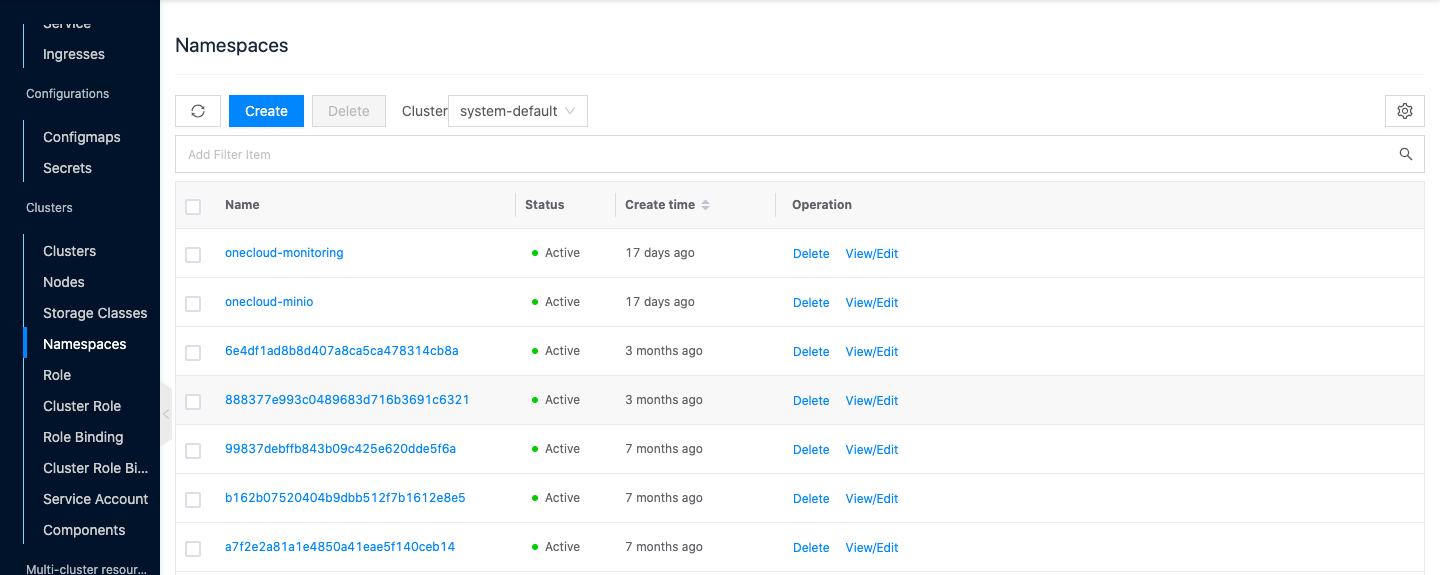Namespaces
Namespaces are used to logically isolate resources in a Kubernetes cluster. Namespaces are suitable for scenarios where there are many users across multiple teams or projects. For clusters with only a few to a few dozen users, there is no need to create or consider namespaces at all. Names of Kubernetes objects under namespaces must be unique. kube-public, kube-system, kube-node-lease-default namespaces are created by default after the Kubernetes cluster is created.
Please see Kubernets Official Documentation - Namespaces for more details on namespaces.
Entry: In the cloud management platform click the top left corner of  navigation menu, and click “Containers/Clusters/Namespaces” menu item in the left menu bar that pops up to enter the Namespaces page.
navigation menu, and click “Containers/Clusters/Namespaces” menu item in the left menu bar that pops up to enter the Namespaces page.

View namespaces
This function is used to view namespace information under different clusters.
-
In the namespaces page, the namespace information under one cluster is viewed by default.
-
When there are multiple clusters in the environment, you can click the input box on the right side of the cluster above the list and select other clusters to view the namespace information under other clusters.

Create namespaces
This function is used to create namespaces under the specified cluster.
- On the namespace page, click the “Create” button at the top of the list to enter the Create namespace page.
- Enter the namespace name, select the cluster, and click the “Deploy” button to create the namespace in the specified cluster.
Delete Namespace
This function is used to delete the namespaces under the specified cluster.
delete
- On the Namespaces page, click the “Delete” button in the action column on the right side of the namespace, and the action confirmation dialog box pops up.
- Click the “OK” button to delete the namespace and related resources.
Batch delete
- Select one or more namespaces in the namespace list, and click the “Delete” button at the top of the list to bring up the action confirmation dialog box.
- Click the “OK” button to delete the namespaces and related resources.
View/Edit
This function is used to view or edit the namespace yaml file.
- On the namespace page, click the “More” button on the right column of the namespace, and select the drop-down menu “View/Edit” menu item to bring up the View/Update dialog box.
- Support viewing and editing yaml file information of namespace.
- After editing the yaml file, click the “OK” button to take effect.
View namespace details
This function is used to view namespace-related information.
- On the namespace page, click the namespace name item to enter the namespace details page.
- View the following information: Cloud ID, ID, name, domain, project, cluster, status, created at, updated at, notes, etc.
View Events
This function is used to record the occurrence of resource object events, including the content, source, cause, and created at, for troubleshooting.
- On the Namespace page, click the namespace name item to enter the namespace details page.
- Click the Events tab to enter the Events page. View the content, source, cause, and created at of the event.
View source information
This function is used to view and edit the namespace yaml information.
- On the namespace page, click the namespace name item to enter the namespace details page.
- Click the “Source Information” tab to enter the source information page.
- Click the “Copy Content” button to copy the yaml file information of the node.
- After updating the yaml file, click the “Update” button.
View Operation Log
This function is used to view the operation logs related to namespaces.
- On the namespace page, click the namespace name item to enter the namespace details page.
- Click the Operation Log tab to enter the Operation Log page.
- Load More Logs: In the Operation Logs page, the list shows 20 operation logs by default. To view more operation logs, please click the “Load More” button to get more logs.
- View Log Details: Click the “View” button on the right column of the operation log to view the log details. Copy details are supported.
- View logs of specified time period: If you want to view the operation logs of a certain time period, set the specific date in the start date and end date at the top right of the list to query the log information of the specified time period.
- Export logs: Currently, only the logs displayed on this page are supported to be exported. Click the upper-right corner of
 icon, set the export data column in the pop-up export data dialog, and click the “OK” button to export the logs.
icon, set the export data column in the pop-up export data dialog, and click the “OK” button to export the logs.